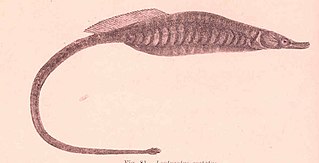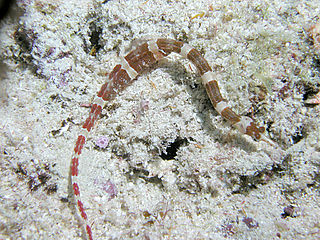
The knobby seahorse, also known as the short-headed seahorse or short-snouted seahorse, is a species of marine fish of the family Syngnathidae. It inhabits coastal waters in southwestern and southeastern Australia, from Gregory to Bremer Bay, and from Denial Bay to Newcastle.
Choeroichthys is a genus of pipefishes of the family Syngnathidae native to the Indian and Pacific Oceans.

The robust ghost pipefish, also known as the blue-finned ghost pipefish, Racek's ghost pipefish, robust-snouted ghost pipefish, or the squaretail ghost-pipefish, is a species of false pipefish belonging to the family Solenostomidae. Its appearance can vary greatly due to its ability to change colors over several hours, but the general body shape and fin shapes allow it to mimic a piece of seagrass.

The deepbody pipefish is a species of pipefish endemic to Australia where it is only found along the southern coast. This species grows to a length of 12.9 centimetres (5.1 in) SL. This species is the only known member of the monotypic genus Kaupus which is named in honour of the ichthyologist Johann Jakob Kaup (1803-1873).

Corythoichthys amplexus, known commonly as the brown-banded pipefish, is a species of marine fish in the family Syngnathidae.
Choeroichthys latispinosus, also known as the Muiron Island pipefish or Muiron pipefish, is a species of pipefish native to the western coast of Western Australia, named for its recorded sighting on South Murion Island. It is thought to inhabit the area from Port Denison to Brecknock Island in the eastern Kimberley region.
Hippichthys cyanospilos, commonly known as the blue-spotted pipefish or bluespeckled pipefish, is a marine fish belonging to the family Syngnathidae, native from the Indo-Pacific area.

Campichthys tryoni is a species of marine fish of the family Syngnathidae. Little is known of this species, but the specimens that have been collected were found on the Queensland coast off of northeastern Australia. It is a rare mainly tan coloured pipefish with brownish markings, it has a white blotch over the eyes, a pale patch above the operculum and it has small white dots along its back and tail. The males frequently show irregular dark barring along their ventral surface. This species is ovoviviparous, with males carrying eggs in a brood pouch until giving birth to live young. The largest known specimen is 7.2 centimetres (2.8 in) long, while males may brood at roughly 6–6 centimetres (2.4–2.4 in). The species was described by James Douglas Ogilby in 1890 from a specimen collected in Moreton Bay, Queensland in 1886 and the specific name honours his friend, Mr Henry Tryon, with whom he enjoyed a collecting trip in Moreton Bay. It is a listed Marine species in Australia under the Environment Protection and Biodiversity Conservation Act 1999.
Choeroichthys sculptus, the sculptured pipefish, is a species of marine fish of the family Syngnathidae.
Choeroichthys smithi is a species of marine fish of the family Syngnathidae. It is found in the western Indian Ocean along the coasts of Reunion, Mauritius, the Seychelles, Madagascar, Tanzania, Mozambique, and South Africa. It is a demersal species, inhabiting tide pools and reef flats in coastal waters where it can grow to lengths of 5 cm. This species is ovoviviparous, with males carrying the eggs and giving birth to live young. The specific name honours the South African ichthyologist J.L.B. Smith (1897-1968) who collected the material which was used as the holotype by Dawson when he described the species.
Choeroichthys suillus is a species of marine fish of the family Syngnathidae. It is endemic to Australia, occurring from Perth, along northern Australia, to southern Queensland. It lives in coral reefs to a depth of 14 metres (46 ft), where it can grow to lengths of 6 centimetres (2.4 in). This species is ovoviviparous, with males carrying eggs and giving birth to live young. Within the reef it is found among coral rubble.

Corythoichthys benedetto, commonly known as Benedetto's pipefish, is a species of marine fish of the family Syngnathidae. It inhabits the Indo-West Pacific, near Thailand, Myanmar, Indonesia, Papua New Guinea, and Australia. It is found on algae-covered rocky surfaces and gorgonian sea fans at depths of 5 to 20 metres, where it can grow to lengths of around 7 centimetres (2.8 in). It is usually found alone, although it can be found in groups of up to four individuals. This species is ovoviviparous, with males brooding when they are at lengths of 5 to 5.5 centimetres. The specific name and common name honour the late Italian prime minister Benedetto Craxi (1934-2000).

Doryrhamphus negrosensis, commonly known as Negros pipefish, flagtail pipefish, Masthead Island pipefish or Queensland flagtail pipefish, is a species of marine fish of the family Syngnathidae. It is found in the Western Pacific Ocean, from Borneo to Vanuatu and the Yaeyama Islands to the Rowley Shoals and the Great Barrier Reef. It lives in mud flats and reefs, both coral and rocky, where it is often associated with sea urchins. It is a rather solitary species which may be found in pairs or small groups. It inhabits depths to 9 metres (30 ft), and can grow to lengths of 6.2 centimetres (2.4 in). Although little is known of its feeding habits, it is expected to feed on harpacticoid copepods, gammarid shrimps, and mysids, similar to other pipefish, it may also act as a cleaner fish like other species in the genus Doryrhamphus. This species is ovoviviparous, with males carrying eggs before giving birth to live young. Males may brood at 4.3 cm. It is a small bluish to bluish-grey pipefish which has a pale stripe along the dorsal side of the head and snout, and a dark fan-like caudal fin which has white margins and an orange base.
Gibbs’ pipefish is a species of marine fish of the family Syngnathidae. It is found in the Western Pacific, from the Great Barrier Reef to Palau, the Chesterfield Islands and New Caledonia. Unconfirmed specimens have been reported off of the Seychelles in the Indian Ocean. It lives in coastal sandy or rubble habitats, as well as areas with sponges and coralline algae, where it can grow to lengths of 8 centimetres (3.1 in). It is expected to feed on small crustaceans, similar to other pipefish. This species is ovoviviparous, with males brooding eggs and giving birth to live young. Males may brood at lengths of around 5 centimetres (2.0 in). The specific name honours P. E. Gibbs, who collected the type material.

The Samoan pipefish, or brown pipefish, is a species of marine fish of the family Syngnathidae. It is found in the Indo-Pacific, from the Red Sea, to Sodwana Bay, to Taiwan, the Marshall Islands, and Samoa, where it inhabits tidepools and coral and rocky reefs to depths of 15 metres (49 ft). It is a solitary species with cryptic habits and is rarely observed. It is likely to feed on small crustaceans, and can grow to lengths of 14 centimetres (5.5 in). This species is ovoviviparous, with males carrying the fertilised eggs in a brood pouch, the folds of which fall well short of the centre of the egg-filled pouch, eventually giving birth to live young.
The spinysnout pipefish is a species of marine pipefish of the family Syngnathidae. It is found in the Indo-Pacific, from Sri Lanka to Samoa, and from Japan and the Marshall Islands to central Australia. It lives in rocky and coral reefs, rubble, lagoons and intertidal zones, often at depths of 2–12 metres (6.6–39.4 ft), where it can grow to lengths of 12 centimetres (4.7 in). It is expected to feed on small crustaceans, similar to other pipefish. This species is ovoviviparous, with males carrying eggs in a brood pouch before giving birth to live young.

Hippichthys heptagonus, the belly pipefish, is a species of freshwater pipefish of the family Syngnathidae. It is found from Kenya and South Africa to the Solomon Islands, and from southern Japan to New South Wales. It is a demersal species, living in the lower parts of rivers and streams, estuary habitats such as mangroves and tidal creeks, and occasionally in large lakes. It feeds on small crustaceans, such as copepods and cladocerans, as well as dipteran and ephemopteran larvae. It can grow to lengths of 15 centimetres (5.9 in). This species is ovoviviparous, with females depositing eggs on the males, who in turn give birth to live young several weeks later. Males may brood at 6.5–7.5 centimetres (2.6–3.0 in).
The short-keel pipefish is a species of fish of the family Syngnathidae. It is known from Darwin to the Torres Strait and southern Papua New Guinea. It lives in coastal fresh and brackish habitats, such as mudflats, mangroves, gravel, sandy and rocky habitats, and coral and shell rubble. It can grow to lengths of 12 centimetres (4.7 in). It is expected to feed on small crustaceans such as copepods, shrimps and mysids, similar to other pipefish. This species is ovoviviparous, with males carrying eggs in a brood pouch before giving birth to live young. Males may brood at 7.8 centimetres (3.1 in).

The beady pipefish is a species of pipefish of the family Syngnathidae. It is found in the Indo-West Pacific, from the western Persian Gulf, to the north central Indian Ocean, to Japan and Australia. It lives in the lower parts of streams and rivers, estuarine habitats such as seagrass beds and mangroves, and shallow inshore habitats, where it can grow to lengths of 16–18 centimetres (6.3–7.1 in). It is expected to feed on small crustaceans, similar to other pipefish. This species is ovoviviparous, with males carrying eggs in a brood pouch before giving birth to live young. Average brood size is 177.
Hippichthys spicifer, commonly known as bellybarred pipefish, banded freshwater pipefish, or blue spotted pipefish, is a species of pipefish of the family Syngnathidae. It is found in the Indo-Pacific, from the Red Sea and East Africa to Sri Lanka and Samoa. It lives in shallow coastal and estuarine habitats such as mangroves, tidal creeks, and the lower reaches of rivers, where it can grow to lengths of 18 centimetres (7.1 in). It is expected to feed on small crustaceans and mosquito larvae. This species is ovoviviparous, with males brooding eggs in a brood pouch before giving birth to live young. It is reproductively active all year, with males and females reaching sexual maturity at 10.8 and 10 centimetres respectively. Brood size can vary significantly, from 114 to 1764, with an average of 604.4 plus or minus 322.8.











